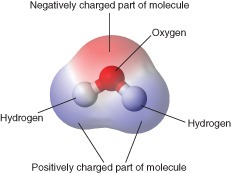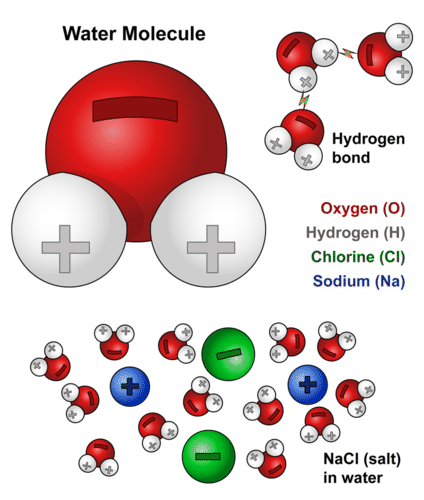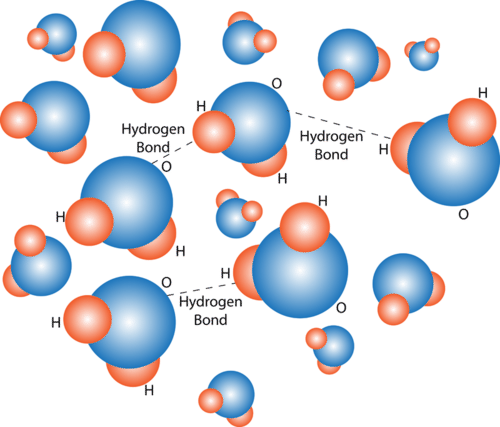What may be the most important molecule for life?
Some may argue DNA. Some may argue certain proteins. But many would argue water. And what makes water so important? Its properties. The nature of the three atoms and how they interact with each other. This allows water to be a polar molecule, which allows it to interact with many other molecules necessary for life. Most of the substances in a cell are floating around in a water-based cytoplasmic environment.
Chemical Structure and Properties of Water
You are probably already familiar with many of water’s properties. For example, you no doubt know that water is tasteless, odorless, and transparent. In small quantities, it is also colorless. However, when a large amount of water is observed, as in a lake or the ocean, it is actually light blue in color. The blue hue of water is an intrinsic property and is caused by selective absorption and scattering of white light. These and other properties of water depend on its chemical structure.
The transparency of water is important for organisms that live in water. Because water is transparent, sunlight can pass through it. Sunlight is needed by water plants and other water organisms for photosynthesis.
Chemical Structure of Water
Each molecule of water consists of one atom of oxygen and two atoms of hydrogen, so it has thechemical formula H2O. The arrangement of atoms in a water molecule, shown in Figure below, explains many of water’s chemical properties. In each water molecule, the nucleus of the oxygen atom (with 8 positively charged protons) attracts electrons much more strongly than do the hydrogen nuclei (with only one positively charged proton). This results in a negative electrical charge near the oxygen atom (due to the "pull" of the negatively charged electrons toward the oxygen nucleus) and a positive electrical charge near the hydrogen atoms. A difference in electrical charge between different parts of a molecule is called polarity. A polar molecule is a molecule in which part of the molecule is positively charged and part of the molecule is negatively charged.
This model shows the arrangement of oxygen and hydrogen atoms in a water molecule. A water molecule has a bent or angular (non-linear) shape, with an angle of about 105°. The nucleus of the oxygen atom attracts electrons more strongly than do the hydrogen nuclei. As a result, the middle part of the molecule near oxygen has a negative charge, and the other parts of the molecule have a positive charge. In essence, the electrons are "pulled" toward the nucleus of the oxygen atom and away from the hydrogen atom nuclei. Water is a polar molecule, with an unequal distribution of charge throughout the molecule.[Figure2]
This model is an atomic diagram of water, showing the two hydrogen atoms and oxygen atom in the center. The protons (red) are in the center (nucleus) of each atom, and the electrons (light blue) circle each nucleus.[Figure3]
This diagram shows the positive and negative parts of a water molecule. It also depicts how a charge, such as on an ion (Na or Cl, for example) can interact with a water molecule.[Figure4]
Hydrogen Bonding
Opposite electrical charges attract one another. Therefore, the positive part of one water molecule is attracted to the negative parts of other water molecules. Because of this attraction, bonds form between hydrogen and oxygen atoms of adjacent water molecules, as demonstrated in Figure below. This type of bond always involves a hydrogen atom, so it is called a hydrogen bond. Hydrogen bonds are bonds between molecules, and they are not as strong as bonds within molecules. Nonetheless, they help hold water molecules together.
Hydrogen bonds form between positively and negatively charged parts of water molecules. The bonds hold the water molecules together. How do you think this might affect water’s properties?[Figure5]
Hydrogen bonds can also form within a single large organic molecule. For example, hydrogen bonds that form between different parts of a protein molecule bend the molecule into a distinctive shape, which is important for the protein’s functions. Hydrogen bonds also hold together the two nucleotide chains of a DNA molecule.
Sticky, Wet Water
Water has some unusual properties due to its hydrogen bonds. One property is cohesion, the tendency for water molecules to stick together. The cohesive forces between water molecules are responsible for the phenomenon known as surface tension. The molecules at the surface do not have other like molecules on all sides of them and consequently they cohere more strongly to those directly associated with them on the surface. For example, if you drop a tiny amount of water onto a very smooth surface, the water molecules will stick together and form a droplet, rather than spread out over the surface. The same thing happens when water slowly drips from a leaky faucet. The water doesn't fall from the faucet as individual water molecules but as droplets of water. The tendency of water to stick together in droplets is also illustrated by the dew drops in Figure below.
Droplets of dew cling to a spider web, demonstrating cohesion, the tendency of water molecules to stick together because of hydrogen bonds.[Figure6]
Another important physical property of water, is adhesion. In terms of water, adhesion is the bonding of a water molecule to another substance, such as the sides of a leaf's veins. This process happens because hydrogen bonds are special in that they break and reform with great frequency. This constant rearranging of hydrogen bonds allows a percentage of all the molecules in a given sample to bond to another substance. This grip-like characteristic that water molecules form causes capillary action, the ability of a liquid to flow against gravity in a narrow space. An example of capillary action is when you place a straw into a glass of water. The water seems to climb up the straw before you even place your mouth on the straw. The water has created hydrogen bonds with the surface of the straw, causing the water to adhere to the sides of the straw. As the hydrogen bonds keep interchanging with the straw's surface, the water molecules interchange positions and some begin to ascend the straw.
Adhesion and capillary action are necessary to the survival of most organisms. It is the mechanism that is responsible for water transport in plants through roots and stems, and in animals through small blood vessels.
Hydrogen bonds also explain why water’s boiling point (100°C) is higher than the boiling points of similar substances without hydrogen bonds. Because of water’s relatively high boiling point, most water exists in a liquid state on Earth. Liquid water is needed by all living organisms. Therefore, the availability of liquid water enables life to survive over much of the planet.
Furthermore, water has a high specific heat because it takes a lot of energy to raise or lower the temperature of water. As a result, water plays a very important role in temperature regulation. Since cells are made up of water, this property helps to maintain homeostasis.
Density of Ice and Water
The melting point of water is 0°C. Below this temperature, water is a solid (ice). Unlike most chemical substances, water in a solid state has a lower density than water in a liquid state. This is because water expands when it freezes. Again, hydrogen bonding is the reason. Hydrogen bonds cause water molecules to line up less efficiently in ice than in liquid water. As a result, water molecules are spaced farther apart in ice, giving ice a lower density than liquid water. A substance with lower density floats on a substance with higher density. This explains why ice floats on liquid water, whereas many other solids sink to the bottom of liquid water.
In a large body of water, such as a lake or the ocean, the water with the greatest density always sinks to the bottom. Water is most dense at about 4°C. As a result, the water at the bottom of a lake or the ocean usually has temperature of about 4°C. In climates with cold winters, this layer of 4°C water insulates the bottom of a lake from freezing temperatures. Lake organisms such as fish can survive the winter by staying in this cold, but unfrozen, water at the bottom of the lake.
Vocabulary
- adhesion: The force of attraction between unlike molecules, or the attraction between the surfaces of contacting bodies.
- boiling point: The temperature at which a liquid changes state into a gas.
- capillary action: The ability of a liquid to flow against gravity in a narrow space.
- cohesion: The tendency for water molecules to stick together.
- homeostasis: The process of maintaining a stable environment inside a cell or an entire organism.
- hydrogen bond: A weak bond between two molecules resulting from an electrostatic attraction between a proton in one molecule and an electronegative atom in the other; always involves a hydrogen atom.
- melting point: The temperature at which a solid changes state into a liquid.
- polarity: A difference in electrical charge between different parts of a molecule.
- polar molecule: A molecule with an unequal distribution of charge throughout the molecule.
- specific heat: The amount of heat per unit mass required to raise the temperature by one degree Celsius.
- surface tension: The energy required to increase the surface area of a liquid due to intermolecular forces.
Summary
- Water molecules are polar, so they form hydrogen bonds. This gives water unique properties, such as a relatively high boiling point, high specific heat, cohesion, adhesion and density.





